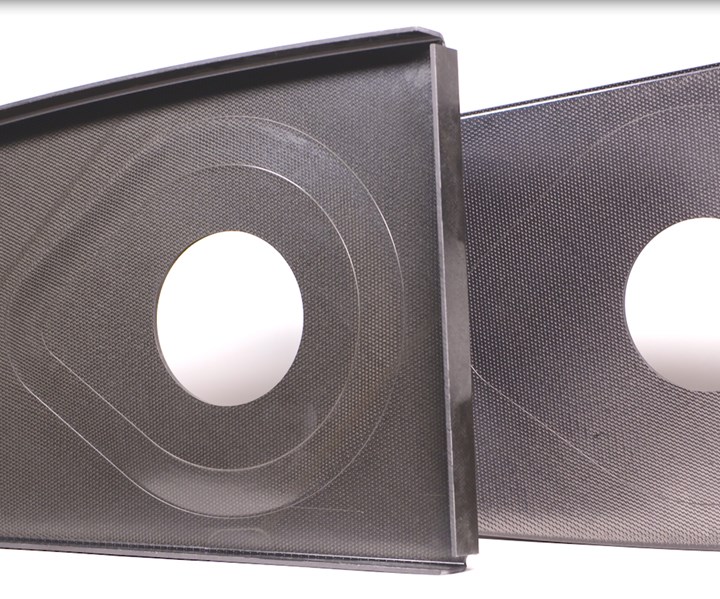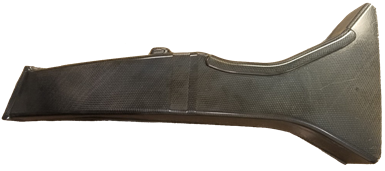Solvay launches epoxy prepreg for aerostructures compression molding
Solvay Composite Materials has launched CYCOM EP2750, a new highly drapable epoxy prepreg designed specifically for the compression molding of high-quality, high-rate, cost-effective primary and secondary aerostructures.

Rib-like parts fabricated with Solvay’s CYCOM EP2750 epoxy prepreg. Source | Luchini, T., Rodriguez, A., Rogers S., Bras A., Whysall, A., Russell, R., Lucas, S., Hahn, G. "Spring Frame Press Fabrication of Aerospace Production Components,” SAMPE 2019.
Solvay Composite Materials (Alpharetta, Ga., U.S.) announced on Feb. 24 that it has launched , a new highly drapable epoxy prepreg designed specifically for the compression molding of high-quality, high-rate, cost-effective primary and secondary aerostructures. The resin can be processed via compression molding only, compression molding with freestanding post-cure, or autoclave cure and offers takt times as short at 15 minutes.
Solvay officials say development of CYCOM EP2750 was stimulated by demand for an epoxy prepreg that allows fabricators to provide high-rate, reliable, cost-effective parts manufacture at aerospace quality. The goal of the prepreg is to enable manufacture of composite parts that are cost- and performance-competitive with machined aluminum.
Solvay points to two aerospace market trends that are likely to benefit significantly from CYCOM EP2750. First, single-aisle replacements for the Boeing 737 and the Airbus A320 aircraft are each expected to be manufactured at or close to 100 units per month. Second is the burgeoning urban air mobility (UAM) market, comprised of small, point-to-point, manned and unmanned aircraft. These likely will be manufactured at rates numbering 3,000-5,000 units per year and, like larger commercial aircraft, will require materials and processes qualified for aerospace application.
For commercial aircraft, CYCOM EP2750 is targeted toward use in access panels, blocker doors, brackets and clips. For UAM and UAV applications, the prepreg is targeted toward use in bulkheads, ribs, fuselage sections, brackets and clips.
Representatives of Solvay anticipate that the preferred process for CYCOM EP2750 will be isothermal press cure, in which the layup is preheated, inserted into the mold, pressed, removed from the mold and then trimmed. This “hot in/hot out” process offers a 95% degree of cure at part removal and has a takt time of 60 minutes at 170°C, or 30 minutes at 190°C. The resin is said to offer low risk of exotherm even at high process temperatures.
Alternatively, CYCOM EP2750 can be pressed to 80% degree of cure, and then post-cured (freestanding) outside the mold. Using this process, parts can be removed from the mold after 15-45 minutes, depending on the cure temperature. For autoclave cure, the prepreg must be ramped up to 177°C for a 30-minute dwell, followed by cool-down. Total take time for this process is 120-180 minutes. Finally, CYCOM EP2750 is compatible with Solvay’s new .

Complex part manufactured with Solvay CYCOM EP2750 epoxy prepreg. Source | Solvay
of CYCOM EP2750 include a service temperature of 132°C, a dry Tg of 197°C and a wet Tg of 168°C. Hot/wet open hole compression strength is 40.5 ksi; room temperature open hole compression strength is 50.5 ksi. Solvay says the National Center for Advanced Materials Performance (NCAMP) at Wichita State University (Wichita, Kan., U.S.) has begun qualification of CYCOM EP2750 that is expected to be completed before the end of 2020.
CYCOM EP2750 is currently being prepregged with Solvay’s 3k-tow, 8-harness Thornel T650 carbon fiber reinforcement. Under development and scale-up are product versions using a 2x2 carbon fiber twill and a unidirectional carbon fiber tape.
CYCOM EP2750 is being formally introduced to the market on the Solvay stand (Hall 5, M41) at the JEC World 2020 exhibition, March 3-5 in Paris. Parts made with CYCOM EP2750 will be on display.
Related Content
Otto Aviation launches Phantom 3500 business jet with all-composite airframe from Leonardo
Promising 60% less fuel burn and 90% less emissions using SAF, the super-laminar flow design with windowless fuselage will be built using RTM in Florida facility with certification slated for 2030.
Read MorePlant tour: Teijin Carbon America Inc., Greenwood, S.C., U.S.
In 2018, Teijin broke ground on a facility that is reportedly the largest capacity carbon fiber line currently in existence. The line has been fully functional for nearly two years and has plenty of room for expansion.
Read MoreThe potential for thermoplastic composite nacelles
Collins Aerospace draws on global team, decades of experience to demonstrate large, curved AFP and welded structures for the next generation of aircraft.
Read MoreDevelopment of a composite liquid hydrogen tank for commercial aircraft
Netherlands consortium advances cryogenic composites testing, tank designs and manufacturing including AFP, hybrid winding, welding of tank components and integrated SHM and H2 sensors for demonstrators in 2025.
Read MoreRead Next
Next-gen fan blades: Hybrid twin RTM, printed sensors, laser shock disassembly
MORPHO project demonstrates blade with 20% faster RTM cure cycle, uses AI-based monitoring for improved maintenance/life cycle management and proves laser shock disassembly for recycling.
Read MoreScaling up, optimizing the flax fiber composite camper
Greenlander’s Sherpa RV cab, which is largely constructed from flax fiber/bio-epoxy sandwich panels, nears commercial production readiness and next-generation scale-up.
Read MoreUltrasonic welding for in-space manufacturing of CFRTP
Agile Ultrasonics and NASA trial robotic-compatible carbon fiber-reinforced thermoplastic ultrasonic welding technology for space structures.
Read More












